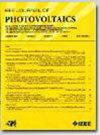具有背面支撑结构的光伏模块中与反照率相关的双面增益损失
IF 2.5
3区 工程技术
Q3 ENERGY & FUELS
引用次数: 0
摘要
双面光伏(PV)模块甚至可以从背面的太阳辐射中发电。因此,双面光伏模块的后侧必须不受结构的阻碍。然而,由于各种其他原因,诸如梁之类的结构通常安装在模块后面以确保结构强度。在这种情况下,由于后侧的部分遮光,双面模块的输出功率降低。这项研究分析了由于后侧支撑结构(如安装、框架和梁)产生的固有部分阴影导致的双面模块中双面增益损失的反照率相关性。实现了光线跟踪与电路仿真相结合的分析方法,并通过现场实验进行了验证。结果表明,当光束紧密附着在模块后侧时,在高反照率下,双面增益呈非线性下降。当将梁放置在与模块的梁厚度相等的距离处时,这种损失减少了一半。结果还表明,模块支撑结构的每个部分都会造成失配损失。本文章由计算机程序翻译,如有差异,请以英文原文为准。
Albedo-Dependent Bifacial Gain Losses in Photovoltaic Modules With Rear-Side Support Structures
Bifacial photovoltaic (PV) modules can generate power even from rear-side solar irradiance. Consequently, the rear side of the bifacial PV module must not be hindered by structures. However, structures such as beams are often installed behind modules to ensure structural strength and for various other reasons. In such cases, the output power of the bifacial module is reduced because of partial shading on the rear side. This study entailed an analysis of the albedo dependence of the bifacial gain losses in bifacial modules due to inherent partial shading produced by rear-side support structures (e.g., mounting, frame, and beams). An analysis method combining ray tracing and electrical circuit simulation was implemented and verified through field experiments. The results demonstrate that the bifacial gain decreases nonlinearly at high albedo when the beam is closely attached to the rear side of the module. This loss is reduced by half upon placing the beam at a distance equivalent to the thickness of the beam from the module. The results also indicate the mismatch loss caused by each part of the module's support structure.
求助全文
通过发布文献求助,成功后即可免费获取论文全文。
去求助
来源期刊

IEEE Journal of Photovoltaics
ENERGY & FUELS-MATERIALS SCIENCE, MULTIDISCIPLINARY
CiteScore
7.00
自引率
10.00%
发文量
206
期刊介绍:
The IEEE Journal of Photovoltaics is a peer-reviewed, archival publication reporting original and significant research results that advance the field of photovoltaics (PV). The PV field is diverse in its science base ranging from semiconductor and PV device physics to optics and the materials sciences. The journal publishes articles that connect this science base to PV science and technology. The intent is to publish original research results that are of primary interest to the photovoltaic specialist. The scope of the IEEE J. Photovoltaics incorporates: fundamentals and new concepts of PV conversion, including those based on nanostructured materials, low-dimensional physics, multiple charge generation, up/down converters, thermophotovoltaics, hot-carrier effects, plasmonics, metamorphic materials, luminescent concentrators, and rectennas; Si-based PV, including new cell designs, crystalline and non-crystalline Si, passivation, characterization and Si crystal growth; polycrystalline, amorphous and crystalline thin-film solar cell materials, including PV structures and solar cells based on II-VI, chalcopyrite, Si and other thin film absorbers; III-V PV materials, heterostructures, multijunction devices and concentrator PV; optics for light trapping, reflection control and concentration; organic PV including polymer, hybrid and dye sensitized solar cells; space PV including cell materials and PV devices, defects and reliability, environmental effects and protective materials; PV modeling and characterization methods; and other aspects of PV, including modules, power conditioning, inverters, balance-of-systems components, monitoring, analyses and simulations, and supporting PV module standards and measurements. Tutorial and review papers on these subjects are also published and occasionally special issues are published to treat particular areas in more depth and breadth.
 求助内容:
求助内容: 应助结果提醒方式:
应助结果提醒方式:


